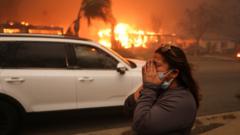Levels of CO2, a crucial greenhouse gas, have skyrocketed this past year, according to the Met Office, which noted that the climb is fundamentally incompatible with international climate pledges made at the Paris Agreement. Despite over 190 countries committing to limiting temperature increases, the incessant rise in CO2 levels indicates a warming trend that now threatens to surpass these ambitious goals.
As evidenced by an ongoing heatwave in parts of India and the world experiencing unprecedented temperatures, the environmental impacts of this increase in CO2 are starkly visible. The recent data showcases not only the emerging crisis in climate stability but also emphasizes the role of human activity—primarily the burning of fossil fuels and extensive deforestation—in propelling CO2 concentrations to their highest levels in at least two million years.
In 2023, fossil fuel emissions reached unprecedented heights, compounded by factors like the El Niño climate phenomenon, which disrupted typical weather patterns and reduced the natural world’s capacity to absorb CO2. The cumulative effect of these factors led to a striking increase of approximately 3.6 parts per million (ppm) from the previous year, surpassing 424 ppm—marking the highest annual increase ever recorded since monitoring began in 1958 at Hawaii’s Mauna Loa Observatory.
Scientists are increasingly concerned about whether the planet's natural systems can effectively capture carbon moving forward. Significantly altered landscapes, such as the Amazon rainforest and Arctic tundra, hinder the natural carbon absorption process due to rising temperatures, droughts, and rampant wildfires.
Though projections suggest a slight decrease in the rate of increase for CO2 levels in 2025, the overall trajectory remains concerningly far from the targets outlined in the Paris Agreement. Experts like Professor Richard Betts of the Met Office warn that while short-term climate variations may provide temporary relief, the overarching trend of rising CO2 levels poses a long-term threat.
With the global community facing urgent challenges in meeting its climate objectives, the time is now for innovative solutions and decisive actions to mitigate the worsening impacts of climate change and safeguard the planet's future.
As evidenced by an ongoing heatwave in parts of India and the world experiencing unprecedented temperatures, the environmental impacts of this increase in CO2 are starkly visible. The recent data showcases not only the emerging crisis in climate stability but also emphasizes the role of human activity—primarily the burning of fossil fuels and extensive deforestation—in propelling CO2 concentrations to their highest levels in at least two million years.
In 2023, fossil fuel emissions reached unprecedented heights, compounded by factors like the El Niño climate phenomenon, which disrupted typical weather patterns and reduced the natural world’s capacity to absorb CO2. The cumulative effect of these factors led to a striking increase of approximately 3.6 parts per million (ppm) from the previous year, surpassing 424 ppm—marking the highest annual increase ever recorded since monitoring began in 1958 at Hawaii’s Mauna Loa Observatory.
Scientists are increasingly concerned about whether the planet's natural systems can effectively capture carbon moving forward. Significantly altered landscapes, such as the Amazon rainforest and Arctic tundra, hinder the natural carbon absorption process due to rising temperatures, droughts, and rampant wildfires.
Though projections suggest a slight decrease in the rate of increase for CO2 levels in 2025, the overall trajectory remains concerningly far from the targets outlined in the Paris Agreement. Experts like Professor Richard Betts of the Met Office warn that while short-term climate variations may provide temporary relief, the overarching trend of rising CO2 levels poses a long-term threat.
With the global community facing urgent challenges in meeting its climate objectives, the time is now for innovative solutions and decisive actions to mitigate the worsening impacts of climate change and safeguard the planet's future.

















